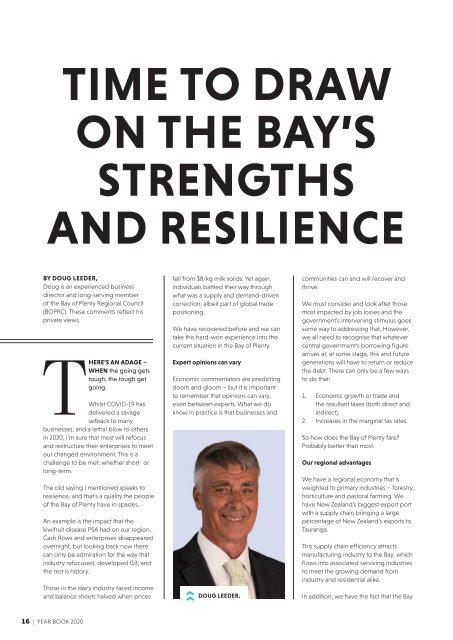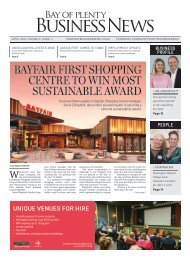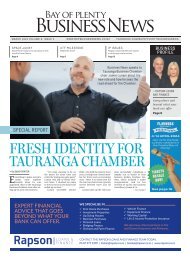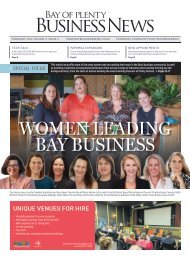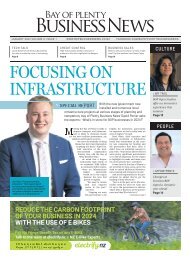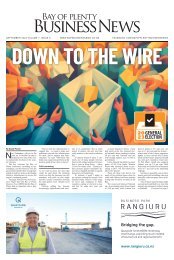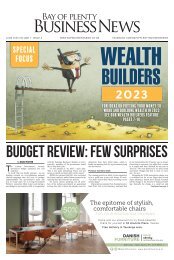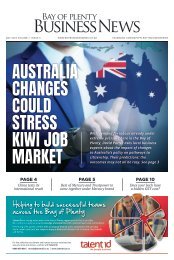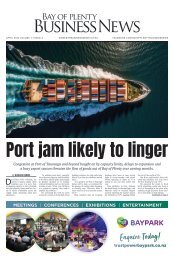Create successful ePaper yourself
Turn your PDF publications into a flip-book with our unique Google optimized e-Paper software.
TIME TO DRAW<br />
ON THE BAY’S<br />
STRENGTHS<br />
AND RESILIENCE<br />
BY DOUG LEEDER,<br />
Doug is an experienced business<br />
director and long-serving member<br />
of the Bay of Plenty Regional Council<br />
(BOPRC). These comments reflect his<br />
private views.<br />
THERE’S AN ADAGE –<br />
WHEN the going gets<br />
tough, the tough get<br />
going.<br />
Whilst COVID-19 has<br />
delivered a savage<br />
setback to many<br />
businesses, and a lethal blow to others<br />
in <strong>2020</strong>, I’m sure that most will refocus<br />
and restructure their enterprises to meet<br />
our changed environment. This is a<br />
challenge to be met, whether short- or<br />
long-term.<br />
The old saying I mentioned speaks to<br />
resilience, and that’s a quality the people<br />
of the Bay of Plenty have in spades.<br />
An example is the impact that the<br />
kiwifruit disease PSA had on our region.<br />
Cash flows and enterprises disappeared<br />
overnight, but looking back now there<br />
can only be admiration for the way that<br />
industry refocused, developed G3, and<br />
the rest is history.<br />
Those in the dairy industry faced income<br />
and balance sheets halved when prices<br />
fell from $8/kg milk solids. Yet again,<br />
individuals battled their way through<br />
what was a supply and demand-driven<br />
correction, albeit part of global trade<br />
positioning.<br />
We have recovered before and we can<br />
take this hard-won experience into the<br />
current situation in the Bay of Plenty.<br />
Expert opinions can vary<br />
Economic commentators are predicting<br />
doom and gloom – but it is important<br />
to remember that opinions can vary,<br />
even between experts. What we do<br />
know in practice is that businesses and<br />
DOUG LEEDER.<br />
communities can and will recover and<br />
thrive.<br />
We must consider and look after those<br />
most impacted by job losses and the<br />
government’s intervening stimulus goes<br />
some way to addressing that. However,<br />
we all need to recognise that whatever<br />
central government’s borrowing figure<br />
arrives at, at some stage, this and future<br />
generations will have to return or reduce<br />
the debt. There can only be a few ways<br />
to do that:<br />
1. Economic growth or trade and<br />
the resultant taxes (both direct and<br />
indirect).<br />
2. Increases in the marginal tax rates.<br />
So how does the Bay of Plenty fare?<br />
Probably better than most.<br />
Our regional advantages<br />
We have a regional economy that is<br />
weighted to primary industries – forestry,<br />
horticulture and pastoral farming. We<br />
have New Zealand’s biggest export port<br />
with a supply chain bringing a large<br />
percentage of New Zealand’s exports to<br />
Tauranga.<br />
This supply chain efficiency attracts<br />
manufacturing industry to the Bay, which<br />
flows into associated servicing industries<br />
to meet the growing demand from<br />
industry and residential alike.<br />
In addition, we have the fact that the Bay<br />
16 | YEAR BOOK <strong>2020</strong>


